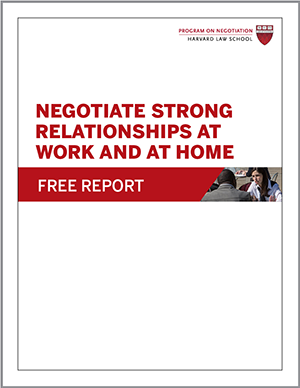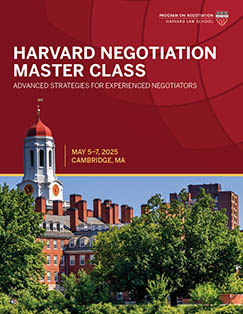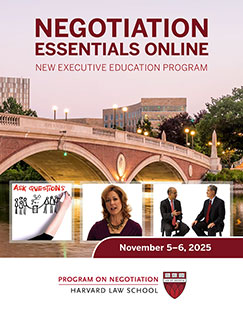
Consider the following disputes:
- A divorcing couple disagrees on the best custody arrangement for their young children.
- A manager accuses his former employer of firing him due to age discrimination.
- An electronics company accuses another company of patent infringement.
In each case, the parties and their lawyers have exhausted their attempts to negotiate a resolution and are ready for outside help. Where should they turn? In addition to negotiation, we have several options when it comes to choosing the right dispute-resolution process, write Frank E. A. Sander and Lukasz Rozdeiczer in The Handbook of Dispute Resolution:
Mediation. The goal of mediation is for a neutral third party to help disputants come to consensus on their own. Rather than imposing a solution, a professional mediator works with the conflicting sides to explore the interests underlying their positions. Mediation can be effective at allowing parties to vent their feelings and explore grievances. Mediators try to help the parties negotiate a resolution that is sustainable, voluntary, and nonbinding.
Arbitration. In arbitration, a neutral third party serves as a judge who, after listening to each side argue its case and present relevant evidence, renders a binding decision. The disputants can negotiate many aspects of the arbitration process, including whether lawyers will be present and which standards of evidence to use. Arbitrators’ decisions are usually confidential and cannot be appealed. Like mediation, arbitration tends to be much less expensive than litigation.
Litigation. Civil litigation typically involves a defendant facing off against a plaintiff before either a judge or a judge and jury, who are responsible for weighing the evidence and making a ruling. Information conveyed in hearings and trials usually enters the public record. Lawyers typically dominate litigation, which often ends in a negotiated settlement before a trial begins.
Choose the Right Dispute-Resolution Process
According to Sander and Rozdeiczer, answering the following three questions can help you choose the right dispute-resolution process for a given dispute:
Question 1: What are my goals? Simply knowing what you want to get out of the dispute-resolution process can help you decide where to start. For example, Carla wants to reach a custody agreement with her husband quickly and inexpensively, and to ensure they both abide by the agreement, she hopes they can negotiate the outcome together. Given these goals, mediation is likely the best choice, as it is typically faster and cheaper than arbitration or litigation, and also gives parties significant control over the final outcome.
By contrast, Jack, who feels his former employer has engaged in age discrimination, has the primary goal of winning a large financial settlement. For him, it may be wise to start with arbitration. If he also wants to set a legal precedent that could benefit others in his situation, he might instead file a lawsuit. In both instances, his attorney(s) can assess his odds of winning the case and a large settlement.
What if you and the other party can’t agree on your goals? Sander and Rozdeiczer advise starting with mediation, as it is a safe, nonbinding procedure for both sides.
Question 2: Which process will capitalize on the best features of the dispute? Every dispute has features that can help you reach a beneficial outcome, write Sander and Rozdeiczer. Which process will best trigger the strengths of the case?
Several dispute features lend themselves well to mediation, the authors write: a good relationship between parties, opportunities for creative problem solving, the willingness of one or both sides to apologize for mistakes or wrongdoing, eagerness to settle quickly, and the presence of multiple issues that might lead to trade-offs.
By contrast, if you would benefit from formal protections, such as enforcement of key decisions, then arbitration or litigation might be a more fitting option. If two companies in a patent dispute distrust each other, they might favor a binding decision and choose arbitration.
Question 3: Which process will best overcome barriers to resolution? Because both sides to a dispute often prefer a negotiated settlement, it’s wise to consider how each dispute-resolution method might help you overcome barriers to settlement, note Sander and Rozdeiczer.
When parties want to air their feelings or when more than two parties are involved, mediation is often the best choice. But when parties have different opinions regarding the law affecting their case, a judge’s or arbitrator’s expertise ultimately may be needed.
When in Doubt, Mediate
When parties are unable to negotiate an end to their dispute on their own, the low-risk, relatively low-cost nature of mediation makes it the “go-to” dispute-resolution process. Mediation allows negotiators to work together toward maximizing their outcomes under the guidance of an expert, rather than handing over their dilemma for someone else to resolve. Mediation is also often the right choice when negotiators plan to work with each other in the future. However, mediation may not be appropriate where there is physical or psychological abuse, or a significant imbalance of power between parties.
If a mediator is unable to help you reach agreement, you may still need to turn to litigation or arbitration, but you will do so with a better understanding of your case and the issues at stake.
What factors and questions do you consider when choosing a dispute-resolution process?





I find it interesting that arbitration is a type of dispute resolution. It is good to know that arbitration is more affordable than other methods. I think it would be crucial to hire an arbitrator with a good track record.
Very resourceful
Oftentimes in practice, disputants usually cool off their emotions by adopting litigation as a method of resolvong their issues. This changes after their emotions settle, and they are now open to other methods of resolution. So there’s a method I call Lit=Med.. Litigation before Mediation. The parties thereafter explore settlement amicably. Their terms of settlement can be adopted as the consent judgement of the court. The issues of time and cost makes them explore this process.
Mediation does result in binding agreements, based on the parties’ mediated discussions. However, binding areements resulting from litigations or arbitrations which are settled are not as frequently complied with as agreements reached after mediation. There is yet a fourth method of dispute resolution not mentioned here. That is facilitated mediated negotiation, during which the mediator takes on a more active roll in guiding the parties towards a resolution. In this type of mediation, the mediator is often expected to have a substantive background in the subject matter.
The benefit of mediation is the fact that the parties to the mediation come to their own agreement. The decisions made by the parties are usually longer lasting compared to the judge or jury in litigation or the arbitrator in an arbitration.